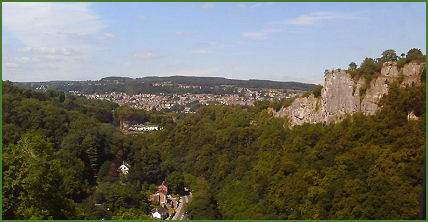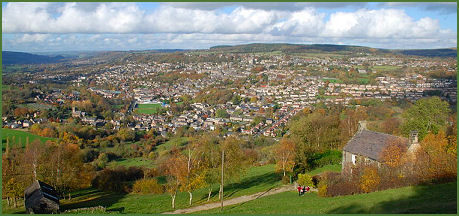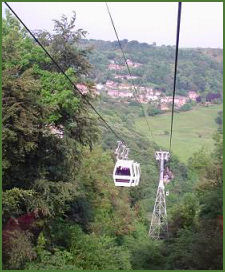Matlock Bath
OS Grid ref:- SK293579
 The unique village of Matlock Bath is situated in a dramatic steep gorge 1.5 miles to the south of Matlock, Derbyshire's county town. Matlock Bath developed as a spa town in the nineteenth century, when it became a fashionable place to visit.
The unique village of Matlock Bath is situated in a dramatic steep gorge 1.5 miles to the south of Matlock, Derbyshire's county town. Matlock Bath developed as a spa town in the nineteenth century, when it became a fashionable place to visit.
 Princess Victoria of Kent (later Queen Victoria) visited the resort on 22nd October 1832 , whilst staying as a guest of the Duke of Devonshire at nearby Chatsworth House. Other famous visitors to the village include John Ruskin, Erasmus Darwin, Josiah Wedgewood and the poet Lord Byron, who compared Matlock Bath with alpine Switzerland, hence its nickname Little Switzerland.
Princess Victoria of Kent (later Queen Victoria) visited the resort on 22nd October 1832 , whilst staying as a guest of the Duke of Devonshire at nearby Chatsworth House. Other famous visitors to the village include John Ruskin, Erasmus Darwin, Josiah Wedgewood and the poet Lord Byron, who compared Matlock Bath with alpine Switzerland, hence its nickname Little Switzerland.
Warm springs, at a constant temperature of 68 degrees fahrenheit, had been discovered at Matlock Bath in 1698, following which a Bath House was built. As the waters became better known, access was improved by the building of the bridge into Old Matlock and in 1783, the opening of a new entrance at the south of the valley.
The Heights of Abraham, a major tourist attraction, is named after the Plains of Abraham in Quebec where James Wolfe died in battle. The park on top of Masson Hill is accessed by a Gondola cable car from the village. Amongst the attractions in the park, which has been open since Victorian times, are cavern and mine tours. The cable car was opened in 1984 and was the first ever alpine cable car in Britain. The route is 568m (621 yards) long and climbs 169 metres . There is also a cliffside cafe in the park.
The Great Rutland Cavern, one of two caves at the Heights of Abraham, consists of a passage and a chamber leading in to the Nestus Grotto and features a display on nineteenth century mining. Masson Cavern is also a former lead mine which has also been adapted as a show cave. A tour of the Great Masson Cavern takes the visitor along a passage through the old Great Rake lead vein. There are miners’ pick and chisel marks on the walls of the Main Hall, from where a passage leads to the Great Chamber where there are are colourful specimens of fluorspar, calcite and barytes.
 The limestone cliffs of High Tor, situated on the opposite bank of the river Derwent, rise to 390 feet and are reputed to be the last place in England where eagles nested. The cliffs are highly popular with climbers and walkers and offer superb views of the Derwent Valley and surrounding countryside. A narrow walkway known as 'Giddy Ledge' winds around a section of the cliff. Behind the summit of the tor are Fern and Roman caves, which are actualy lead veins and not natural caves. It is not possible to date the workings but they are probably among the oldest in the area and may be Roman in origin. Both caves are accessible to the public.
The limestone cliffs of High Tor, situated on the opposite bank of the river Derwent, rise to 390 feet and are reputed to be the last place in England where eagles nested. The cliffs are highly popular with climbers and walkers and offer superb views of the Derwent Valley and surrounding countryside. A narrow walkway known as 'Giddy Ledge' winds around a section of the cliff. Behind the summit of the tor are Fern and Roman caves, which are actualy lead veins and not natural caves. It is not possible to date the workings but they are probably among the oldest in the area and may be Roman in origin. Both caves are accessible to the public.
 Pic Tor Promenade runs between the cliffs of Hight Tor and the River Derwent. Riverside paths link the formal Knowleston Gardens to the Pig Tree Meadows. There are a number of paths offering pleasant walks through woodland.
Pic Tor Promenade runs between the cliffs of Hight Tor and the River Derwent. Riverside paths link the formal Knowleston Gardens to the Pig Tree Meadows. There are a number of paths offering pleasant walks through woodland.
The Grand Pavilion houses a Tourist Point and the interesting Peak District Mining Museum, which tells the story of of lead mining in the area from Roman times to present day. Adjacent to the museum is Temple Mine, where there is a self guided tour, illustrating geology, fossilization and mining technigues.
Further tourist attractions include Gulliver's Kingdom theme park, which is aimed at 3 to 13 year olds in particular, the Life in a Lens Museum of Photography and Old Times and the Matlock Bath Aquarium, housed in the Old Bath House, which dates back to the nineteenth century and was built by by John Smedley, who played a large role in shaping Matlock Bath. The aquarium contains a selection of British and Tropical freshwater species. From Piranhas to Terrapins and many interesting fish from different regions of the world including the beautiful Malawi Cichlids. Reminders of the building's former splendour can be seen in the fine stone staircase, the drinking fountain and huge iron girders spanning the thermal pool. Also of interest at the Aquarium is the Petrifying Well, where visitors can see the ‘petrifying’ process taking place in the working well as the famous Matlock Bath thermal water is sprayed onto objects gradually turning them to stone.
In autumn of each year, the "Venetian Nights" are held with illuminations along the river and illuminated boats, attracting thousands of visitors.
Nearby places of interest
Lea Gardens are situated near the town of Matlock. The garden nestles in a south west facing slope at an height of 700 feet above sea level on the northern edge of the Amber Valley, with scenic views of the Peak District hills beyond.
Lumsdale Valley, above the town of Matlock, is a thickly wooded gorge of outstanding natural beauty and a very interesting history, with stone ruins, waterwheels, ponds and waterfalls.
Chatsworth House known as "The Palace of the Peak" is the country seat of the Duke of Devonshire and is situated on the banks of the River Derwent, 3.5 miles to the northeast of Bakewell in the heart of the Peak District National Park.
Dovedale a dramatic limestone ravine, with its impressive rock outcrops and tranquil woodlands is arguably the prettiest and most famous of the dales in the Peak District National Park.
Image 3 courtesy of Rob Bendall
Back to Top
